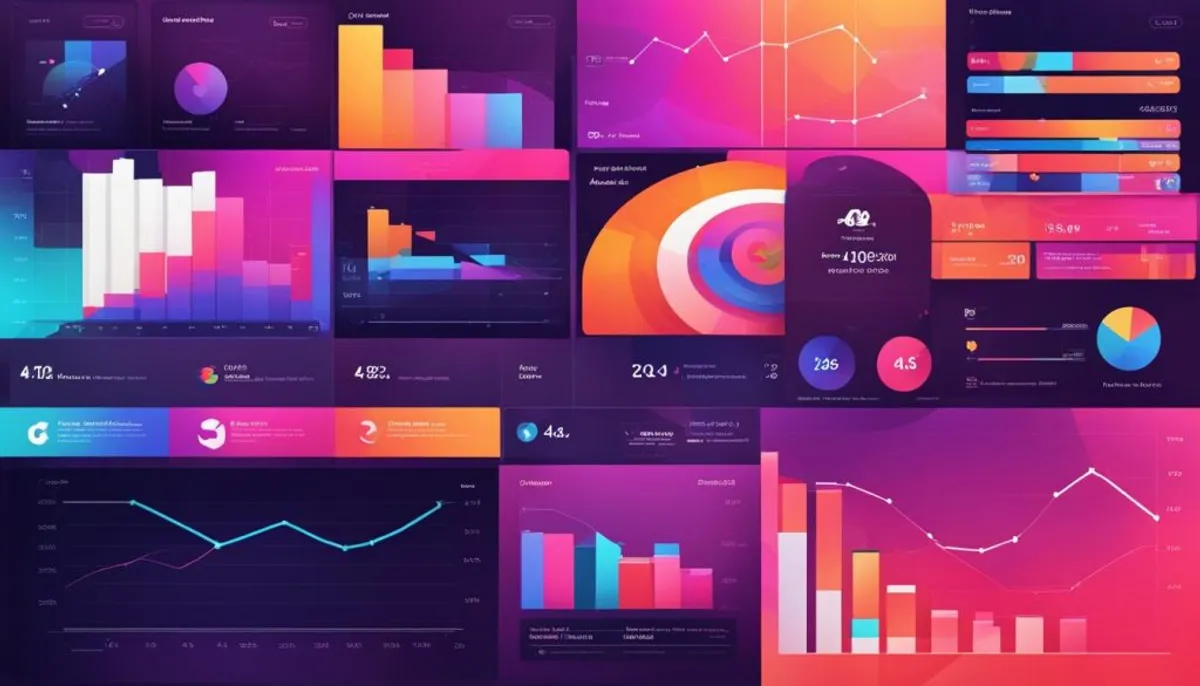Social media has become an essential tool for small businesses aiming to grow. It allows them to connect with their audience instantly. This helps build their brand, increase engagement, and meet business goals.
Before jumping into social media, it’s key to have a strategy. You should set goals that match your business aims. This makes it easier to measure success and make informed choices.
Knowing your audience is crucial for a good social media plan. A youtube social media strategy can help you find out what they like and how they use the internet. This lets you communicate in ways they enjoy, which boosts engagement and relationships.
Choosing the right platforms depends on your audience and their preferences. It could be Facebook, Instagram, LinkedIn, or TikTok. Picking the ones that fit your goals is important for reaching more people.
To keep your audience interested, you must create captivating content. Mix educational, fun, and promotional posts. Try using different formats like images, videos, infographics, and visual channels. Encouraging your followers to share their own content builds a community feel.
Working with influencers can also help your business grow on social media. Choose influencers who believe in your values and have a loyal following. Their credibility can make your brand more trusted and known.
Interacting with your followers is key to building loyalty. Answer their comments and messages to show you care. Using tools to listen to social media helps you keep up with trends and meet customer needs.
Starting a company blog can boost your growth on social media. Create new and relevant content that interests your audience. This will not only increase your visibility but also drive more traffic to your blog. Using your blog and social media together strengthens your online presence, especially through visual channels.
Looking at your competitors’ social media can also offer useful insights. Learn what your industry’s customers expect and see what your rivals might be missing. Then, you can improve your own strategy and stay ahead.
Key Takeaways:
- Define your goals and objectives before using social media to drive business growth.
- Research and understand your target audience to tailor your messaging and tone and enhance engagement.
- Choose the right social media platforms that align with your business objectives and target market.
- Create engaging and diverse content that captures your audience’s attention.
- Leverage influencer marketing to expand your reach and build authenticity.

The Importance of Goal Setting and Target Audience Research
Setting clear goals is the first step in social media marketing. This lets businesses track progress and make smart choices. Specific, measurable objectives help focus the strategy.
Knowing your audience is also key. Learn their interests and online habits to make your messages stick. By utilizing visual channels, your content really speaks to them, boosting engagement and connections.
It’s vital to pick the right social media platforms. Since different groups use different platforms, choose where your audience hangs out. This ensures your messages are seen by the right eyes.
A good content plan mixes information, fun, and ads. This combo keeps followers engaged and meets their needs. Understanding the content creation process is essential, and using influencers can also help your brand seem more real and trustworthy.
Staying active with your audience builds strong relationships. Reply to comments and show you care. A unique brand identity, complete with visual style, makes your business stand out.
The Benefits of Goal Setting and Target Audience Research:
- Maximize social media impact by setting clear goals and measurable objectives
- Tailor messaging and content to suit the target demographic
- Select the most relevant social media platforms for reaching the target audience
- Create engaging content through a mix of informative, entertaining, and promotional posts
- Leverage influencer marketing to expand reach and build authenticity
- Regularly engage with the audience to foster loyalty and trust
- Build a strong and recognizable brand identity
Goal setting and audience research are crucial. They help businesses fine-tune their social media strategy. This leads to better connections and a foundation for growth.
Choosing the Right Social Media Platforms
Choosing the right social media for your business is crucial. You must pick platforms that match your audience and goals. There are many social media sites, each with special features and users. Making smart choices is key to engaging your audience connection well.
First, choose social media sites important to your business and market. Think about where your audience likes to spend time online. Also, consider what’s popular in your industry. This helps you focus your efforts and use your resources wisely.
Before deciding, think about each platform’s features and users. For instance, LinkedIn is great for professionals and B2B companies. It’s good for networking, getting industry news, and sharing ideas. Meanwhile, Instagram and TikTok are better for reaching young people. They allow for creative and engaging visual content.
To pick the right platforms, make sure they match your business goals. For increasing brand awareness and reaching more people, try Facebook and Twitter. They have many users. If you want to show off your products visually, Instagram and Pinterest are good choices. Always think about your audience and where they like to hang out.
Picking the right social media is all about strategy. It helps you meet your audience and reach your business targets. By choosing platforms that fit your goals and engage your audience, including social media gg, you can boost your brand. This will drive engagement and help your business grow and succeed.

Creating Engaging Content
Compelling content is key to a great social media strategy. It grabs your audience’s attention, helping you connect in meaningful ways. Include informative, entertaining, and promotional posts in your content plan.
Varying your content types makes things more interesting. Use eye-catching images, videos, infographics, and user-generated content. This keeps your audience engaged and eager to see more.
Getting your audience involved is crucial. Ask questions that spark conversations. Run contests to encourage participation. Share user-generated content to highlight your audience’s creativity. This makes your followers feel part of your community, increasing their loyalty.
Having a consistent posting schedule lets your fans know when to expect new content. Post when your audience is most active online to increase visibility and engagement. Being regular and predictable keeps your online community lively. Additionally, incorporating tiktok marketing strategies can enhance your reach and effectiveness in engaging with your audience.
It’s important to track your audience analytics to see what works. Analyze likes, comments, shares, and click-through rates to learn more about what your audience likes. Let this information guide your content choices and decisions.
| Content Strategy | Types of Posts |
|---|---|
| Informative | Industry insights, educational content, how-to guides |
| Entertaining | Humorous content, inspirational stories, behind-the-scenes glimpses |
| Promotional | Product announcements, limited-time offers, discounts |
| User-generated content | Contests, challenges, customer testimonials |
A solid content strategy grabs your audience, boosts engagement, and helps grow your business.
Leveraging Influencer Marketing
In today’s digital world, influencer marketing is a key way for businesses to build credibility and reach more people. By partnering with influencers who have a loyal following, you can improve your brand’s reputation and trustworthiness. Here are steps to use influencer marketing effectively:
- Identify Influencers with a Loyal Audience: Choose influencers who match your brand’s values and have a loyal audience. Look for influencers who fit your target market and are trusted in their field.
- Collaborate for Maximum Impact: There are many ways to work with influencers, like product reviews, sponsored content, or giveaways. Collaborating lets you access their followers and increase your brand’s exposure.
- Build Authenticity and Trust: Influencer marketing can make your brand seem more real and trustworthy to your target audience. When influencers speak well of your brand, it boosts your reputation and builds trust with their followers.
- Transparency is Key: Being open about your partnerships with influencers is very important. Make it clear when content is sponsored. This honesty builds trust with both the influencer’s audience and yours.
Influencer marketing is a great way for businesses to grow their audience and connect with more people. By using the reach and trust influencers have, you can make your brand more respected, connect genuinely with your audience, and drive growth. However, it is essential to be aware of potential social media issues that can arise during these campaigns.

Benefits of Influencer Marketing
| Benefits | Description |
|---|---|
| Increased Credibility | Influencers endorse your brand, enhancing credibility among their followers. |
| Expanded Reach | Tap into the vast audience of influencers to reach new potential customers. |
| Loyal Audience | Influencers have a dedicated audience that actively engages with their content. |
| Collaborative Opportunities | Work together with influencers to create compelling content and promotions. |
| Authenticity and Trust | Influencers help build authenticity and trust with their audience, benefiting your brand reputation. |
| Improved Brand Reputation | Positive endorsements from influencers can enhance your brand’s reputation. |
Using influencer marketing can change the game for businesses aiming to boost their online presence, credibility, and audience connection. Working with influencers who share your brand values helps you reach more people authentically and improve your brand image. Additionally, leveraging trapp networks pr can enhance your outreach efforts and further solidify your brand's reputation.
Engaging and Interacting with Your Audience
Building a strong presence on social media involves more than just posts. You need to actively engage and talk to your followers. This helps you create a loyal community and keeps your customers coming back.
Interacting on social media is a give and take. Make sure to reply to comments, messages, and any mentions. This shows you care about your audience’s thoughts and issues. It builds trust and encourages more interaction.
Remember, your engagement shouldn’t just focus on negative comments. Always say thanks for positive feedback. Spark conversations and ask questions that make people want to share their views.
Using social listening tools is another great way to engage. They let you hear what people are saying about your business and industry, and also how they interact through various visual channels. This helps you understand what your customers like and what trends are emerging. Knowing this keeps you ahead and makes your business look good in the eyes of your customers.
When you listen and respond to your customers, they’re more likely to talk about your business to others. Customer praise is powerful. It helps you attract new people and grow your business.
Businesses that focus on interacting with their audience do better in the long run. They build a strong online community, make customers happy, and see success in their content creation process and business.
| Benefits of Engaging and Interacting with Your Audience: |
|---|
| Promotes audience engagement and loyalty |
| Builds trust and fosters positive relationships |
| Drives word-of-mouth advertising and brand advocacy |
| Provides valuable customer feedback and insights |
| Allows for efficient addressing of client demands |
The Benefits of Creating a Company Blog
A company blog is key for a great social media strategy. It’s where you show your skills, post valuable content, and talk with your audience.
Posting new and relevant content often keeps your audience hooked. This boosts your brand’s visibility and brings more visitors to your site.
One big perk of a company blog is answering common questions. You can explain your products or services in detail, creating engaging content for gamers. This way, your audience gets to know your offerings and sees you as an expert.
“A company blog allows you to share insights, stories, and tips that resonate with your target audience, fostering trust and credibility.”
Linking your blog with social media can boost your site’s visits and engage more followers. When you share your blog on social pages, it reaches more people and increases your site’s traffic.
Example Use Case: XYZ Corporation
XYZ Corporation, a top tech firm, knows the importance of a company blog. They publish new, informative content regularly. This has gained them a big audience and a reputation as industry leaders.
They also share their blog posts on social media to get even more reach. This approach has raised their engagement and awareness.
Analyzing Competitors and Identifying Opportunities
Studying your competitors is key to a great social media strategy. By knowing their strengths and weaknesses, you can find valuable insights. These insights help you see chances for your business to shine. Knowing what your competitors do lets you meet customers’ expectations better.
Start your analysis by looking at your competitors’ social media. Check which platforms they use and how engaged their audience is. This shows you where your business should be active. Also, observe the kind of content they share and how well it works. This helps you understand what content engages the audience.
Spot weaknesses or places your competitors aren’t using well. Use these gaps to make your business stand out. For instance, if they’re not much on a platform your audience loves, be more active there. This way, you can reach more people.
Also, take a close look at how your competitors handle content. Try to create content that stands out and is valuable to your audience. Find out which posts get a lot of engagement. Use that knowledge to make your content strategy even better. By keeping an eye on your competitors and the market, you can make your business successful on social media. Additionally, consider the instagram business profile features that can enhance your visibility and engagement.
Example Table: Comparison of Competitors’ Social Media Platforms
| Competitor | ||||
|---|---|---|---|---|
| Competitor A | High engagement, effective for promotions | Minimal presence | Active with visually appealing content | No presence |
| Competitor B | Consistent posts with moderate engagement | Active with regular updates | Highly engaged audience, influencer collaborations | Active with professional networking |
| Your Business | Opportunity to increase engagement and promotions | Potential to be more active for customer interaction | Unexplored potential for increased brand visibility | Untapped professional network |
Conclusion
Small businesses can grow by using the right social media strategies. They can reach more people and connect with their audience. It’s important to keep an eye on how things are going and to change plans when needed.
Success needs hard work and sticking with it. Companies have to keep up their social media game. They need to talk to their audience often to build trust and loyalty.
Social media always changes, so businesses must stay proactive. By putting in time and effort in the content creation process, they can really benefit from social media. Let the power of social media help your business flourish.
FAQ
How can I use social media to grow my business?
Social media is key for small businesses to connect with their audience. You need clear goals, know your audience, and pick the right platforms. This lets you create content that speaks to them, use influencer marketing, and interact often to build loyalty and trust. Incorporating a youtube social media strategy can further enhance your outreach and engagement efforts.
How do I define goals for my social media marketing strategy?
First, set clear objectives that match your business’s aims. By doing so, you can track your performance and make smart choices. Learn about your audience’s traits, interests, and online behaviors through thorough research.
How do I choose the right social media platforms for my business?
Picking platforms that fit your business and audience is crucial. Think about each platform’s features and who uses them. LinkedIn is great for professionals, while Instagram and TikTok appeal to younger folks.
How do I create engaging content for social media?
Eye-catching content is vital for social media success. Plan a content strategy that blends educational, fun, and promo posts. Try different formats like photos, videos, and infographics. Engage your followers with quizzes, contests, and asking for their content.
How can influencer marketing help my business?
Using influencer marketing boosts your business’s trust and reach. Find influencers who fit with your brand’s values and have engaged followers. Collaborate on reviews, sponsored content, or giveaways. This can make your brand seem more trustworthy and reputable.
How important is audience engagement on social media?
Interacting with your audience regularly is essential for building connections and fostering an audience connection. Start conversations, solve problems, and thank them for compliments. This engagement builds loyalty, trust, and spreads the word about your business.
Why should I consider creating a company blog?
A blog is key for a strong social media approach. By regularly posting new, relevant content, you’ll keep your audience interested. Use your blog for FAQs and deep dives into topics. Linking social media and blogging boosts blog visits and social media interaction.
What benefits come from analyzing competitors and identifying opportunities?
Study your competition to understand their pluses and minuses. Know what your industry’s customers are looking for by watching your rivals. Spot chances to stand out based on what your competition lacks on social media.
How can I maximize the impact of social media on my business?
With these tips, small businesses can make the most of social media to grow. Keep an eye on your progress and adjust your plans as needed. Always stay aware of new trends on social media. Being dedicated and consistent is crucial for social media success.
RelatedRelated articles



